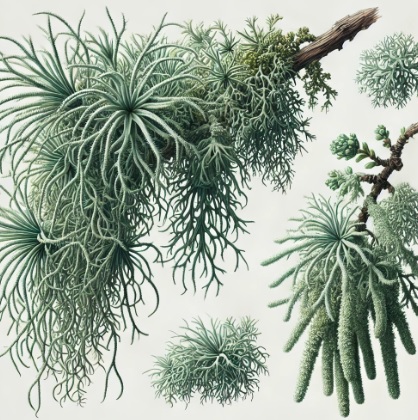The Usneaceae family is a group of lichens belonging to the order Peltigerales. It primarily includes the genus Usnea, known for its ability to grow on trees, rocks, and other exposed surfaces in temperate and tropical environments. These lichens are highly valued for their medicinal properties, as well as their use in cosmetics and perfumery, due to the bioactive compounds they contain.
General Description
Lichens in the Usneaceae family share several distinctive characteristics:
- Morphology: Usnea lichens typically have a filamentous vegetative body, known as the thallus, which appears as a string or hanging filament. These filaments are usually gray-green or yellow-green and highly branched.
- Growth: Usnea lichens are epiphytic, meaning they grow on other plants or surfaces such as tree trunks, branches, and rocks. They are not parasitic but rely on the environment for nutrients and water.
- Reproduction: Usnea lichens reproduce primarily through the formation of soralia, small structures containing spores. Sexual reproduction occurs through the formation of apothecia, which are fruiting bodies containing spores.
Chemical Composition
Lichens of the Usneaceae family are known to contain a variety of bioactive compounds, many of which have medicinal and therapeutic properties:
- Usnic Acid: Usnic acid is one of the main active compounds found in Usnea lichens. It has antimicrobial, antiviral, anti-inflammatory, and analgesic effects. Usnic acid is used in traditional medicine to treat infections, wounds, and as a tonic.
- Polyphenols and Flavonoids: The flavonoids and polyphenols present in Usnea lichens have antioxidant, anti-inflammatory, and antimicrobial properties. These compounds are often used to support immune function.
- Glycoproteins and Polysaccharides: These compounds found in Usnea are believed to enhance immune system activity and may have therapeutic effects, particularly in supporting the body’s defense against infections.
- Lecithins: Lecithins in Usnea lichens are important for cell membrane formation and have potential applications in skincare products due to their moisturizing properties.
Physical Properties
Lichens in the Usneaceae family exhibit several physical traits that are characteristic of parasitic plants:
- Thallus: The vegetative body of Usnea lichens is made up of thin, branching filaments that can appear as a mass of hanging threads. These filaments are highly sensitive to humidity and change color in response to environmental conditions.
- Color: Usnea lichens are typically gray-green, yellow-green, or white, with a soft, velvety texture.
- Internal Structure: Inside the thallus, Usnea lichens contain green algae and symbiotic fungi. The algae photosynthesize solar energy, while the fungi provide structural support and absorb moisture.
Production and Harvesting
Usnea lichens are primarily harvested for the production of extracts used in medicine and cosmetics:
- Usnea Extracts: Extracts obtained from Usnea lichens are used in medicinal preparations to leverage the antimicrobial and anti-inflammatory properties of usnic acid. These extracts may be used in creams, lotions, ointments, and teas.
- Harvesting: Usnea lichens are typically collected from trees or rocks in natural environments. Harvesting should be done sustainably to avoid damaging the ecosystem.
Applications
Medicinal
Lichens from the Usneaceae family, particularly Usnea, have long been used in traditional medicine for their therapeutic properties:
- Antimicrobials: Usnic acid is known for its powerful antimicrobial properties. It is used to treat bacterial and fungal infections, including respiratory infections such as cough, bronchitis, and asthma.
- Anti-inflammatory: The compounds in Usnea lichens have anti-inflammatory properties that may be helpful in treating chronic inflammatory diseases such as arthritis.
- Antivirals: Usnea extracts have been studied for their potential in treating viral infections, such as influenza and the common cold.
Cosmetics
Thanks to its antimicrobial, anti-inflammatory, and antioxidant properties, Usnea lichen is also used in cosmetics:
- Skincare: Usnea extracts are used in creams, lotions, and ointments for their antibacterial properties and for soothing irritated or inflamed skin. They are also useful for treating acne and other skin infections.
- Antioxidant: Usnic acid and flavonoids found in Usnea lichens are used to protect the skin from free radical damage, preventing premature aging.
Environmental
Lichens from the Usneaceae family play an important role in the environment:
- Bioindicators: Lichens are sensitive to environmental conditions, especially air pollution. The abundance and health of lichens can be used as indicators of air quality in a region.
- Habitat: Usnea lichens provide shelter and food for various bird species and insects, contributing to biodiversity in forest and mountain ecosystems.
Environmental and Safety Considerations
While Usneaceae lichens offer many benefits, there are a few considerations:
- Sustainability: The harvesting of Usnea should be done sustainably to prevent damage to natural habitats. Lichens are slow-growing organisms, and overharvesting can threaten natural populations.
- Toxicity: Although usnic acid has many beneficial properties, it can be toxic in large quantities if ingested or improperly used. It is important to use Usnea extracts with caution and under the supervision of an expert in herbal medicine.
INCI Functions
- Antioxidant: Protects the skin from oxidative damage.
- Anti-inflammatory: Reduces inflammation and soothes the skin.
- Antimicrobial: Helps combat harmful microorganisms on the skin.
- Moisturizing: Helps hydrate and retain moisture in the skin.
Conclusion
The Usneaceae family is a fascinating group of lichens that provide numerous medicinal, cosmetic, and environmental benefits. Usnea is particularly known for its antimicrobial and anti-inflammatory properties and is used in traditional medicine to treat infections and inflammatory diseases. Additionally, due to its antioxidant properties, it is a valuable ingredient in skincare products.
![]() Usneaceae
Usneaceae 
